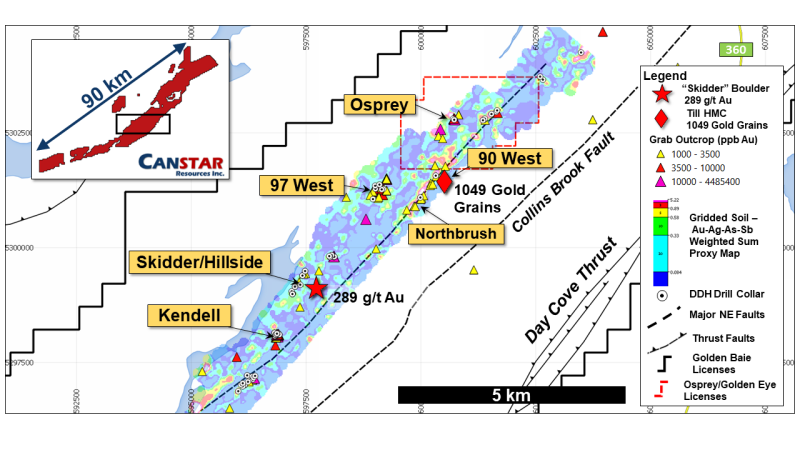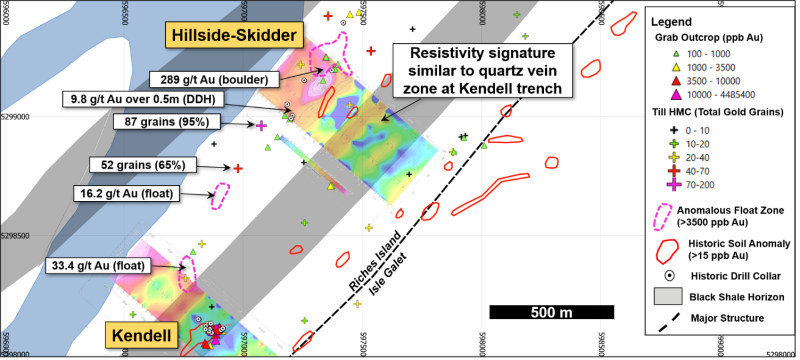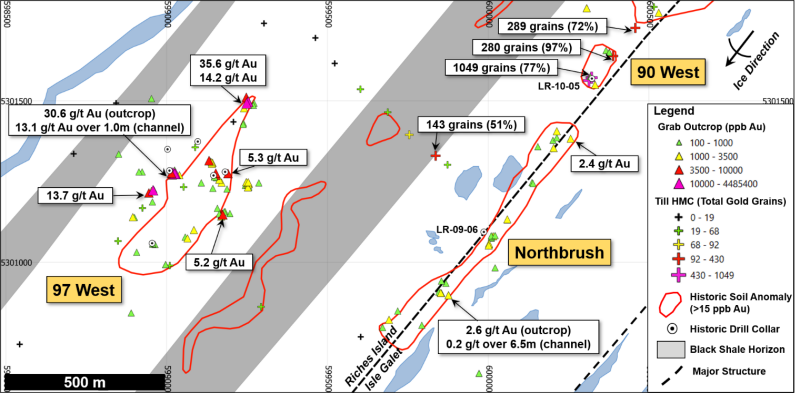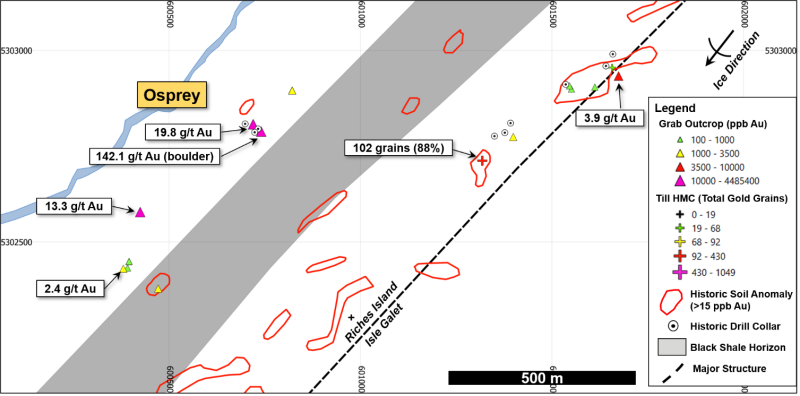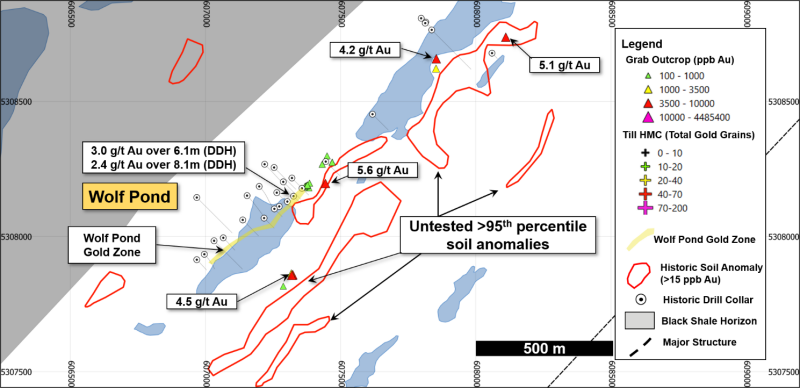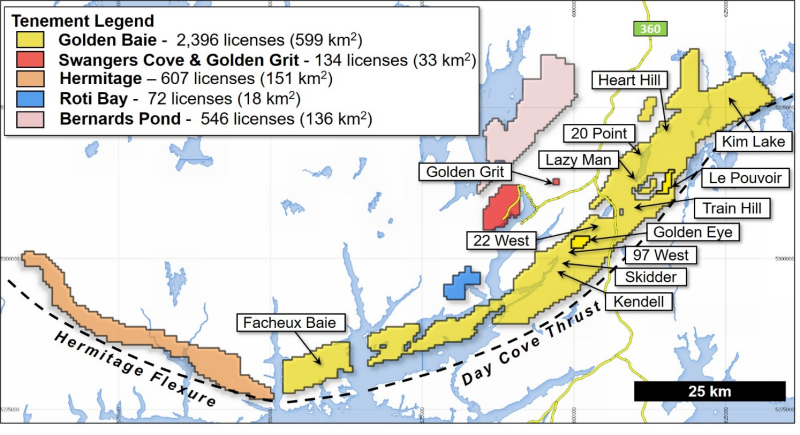Archive
Canstar Commences Drilling of Multiple Targets on the Golden Baie Project in South-Central Newfoundland
 | |||||||||
 | |||||||||
Toronto, Ontario – TheNewswire - September 20, 2022 – CANSTAR RESOURCES INC. (TSXV:ROX) & (OTC:CSRNF) (“Canstar” or the “Company”) is pleased to announce that it has commenced drilling on its Golden Baie project. This is the third drill program by the Company on the Golden Baie project.
Planned drilling will test six target areas, including follow up on winter drilling at the Kendell prospect, (see news release dated July 5, 2022), which returned near-surface intercepts including 20.6 grams per tonne (“g/t”) gold over 3.5 metres (“m”). To date, gold mineralization at the Kendell prospect has been defined for approximately 180 m downdip from surface and mineralization remains open to the northwest. Optical and/or Acoustic Televiewer (“ATV/OTV”) data from select 2021 and 2022 drill holes provides a better understanding of the vein orientations associated with the gold mineralized zones and will be used to orient the next drill holes at the Kendell prospect.
Drilling is also planned to test at least five additional targets in the central portion of the Golden Baie claims (Figure 1) that have been selected based on recent trenching, till sampling results, an IP survey completed this summer, and historical data. Initial drill holes are expected to be shallow, averaging approximately 100 m each, as the geology in this area is typically shallow dipping to the northwest. Initial drilling is expected to total at least 5,000 m in 50-60 holes.
Overview of Drill Targets
|
Hillside/ Skidder |
In 2021, reconnaissance drilling in this glacial till covered area intersected 9.8 g/t gold over 0.5 m with visible gold hosted in quartz veining at shallow depth (hole GB-21-23 - news release dated May 4, 2022). Also in 2021, the Company discovered a boulder at the Skidder target with visible gold in quartz that assayed 289 g/t gold in a grab sample* (news release dated Nov. 11, 2021). A recent IP survey indicates a resistivity target east of the 2021 drilling, which will be tested in planned drilling (Figure 2). |
|
90 West/ Northbrush |
Drilling will begin to test a 1.1 kilometre (“km”) trend of anomalous soil and rock grab samples (up to 2.6 g/t gold) that is proximal to the interpreted contact of the Isle Galet volcano-sedimentary and Riches Island sedimentary formations (Figure 3). This trend also hosts the till samples with 1,049 and 502 gold grains (see news releases dated May 4 and Aug. 30, 2022). |
|
97 West |
Drilling will target the down-dip extension of a channel sample assaying 13.1 g/t gold over 1.0 m in trench 97W-21-TR01 (see news release dated Jun. 7, 2022) and outcropping quartz vein samples with up to 35.6 g/t gold in an area with no previous trenching or drilling (Figure 3). |
|
Osprey |
The Osprey target is located on recently acquired claims to the northeast of the 97 West target (news release dated Aug. 15, 2022). Historic grab samples from this target range up to 19.8 g/t gold in outcrop (Figure 4). |
|
Wolf Pond |
The Wolf Pond target is located approximately 10 km northeast of the 90 West target. Historic drilling in the 1980s defined a mineralized zone of 450 m by 10 m with shallow intercepts of 3.0 g/t gold over 6.1 m (DDH WF-87-04) and 2.4 g/t gold over 8.1 m (DDH WF-87-09). Planned drilling will evaluate a 750 m by 50 m gold-in-soil anomaly that has never been drill tested and is located approximately 300 m to the southeast of historic drilling in the area (Figure 5). |
* Note that rock grab samples are selective by nature and values reported may not represent the true grade or style of mineralization across the property.
Figure 1 - Little River Trend on the Golden Baie project showing soil anomaly heatmap and priority targets
Hillside/Skidder Target
The Skidder target is located approximately 1.2 kilometres north-northeast of the Company’s Kendell prospect (Figure 2) and appears to be a similar style of orogenic gold mineralization. Rock sampling in the target area has defined a 500 m by 400 m gold anomaly with outcrop grab samples containing up to 30.3 g/t gold. Multiple anomalous float rock samples were also found in this area, generally assaying between 1 g/t and 10 g/t gold, and visible gold was noted in two float rocks which assayed 21.7 g/t gold and 289.4 g/t gold. The latter sample is referred to as the “Skidder boulder” and it is inferred to have a nearby bedrock source, based on till analysis and an understanding of regional glaciation. The area is mostly covered by till, and systematic drilling is planned with the aim of locating the source of the Skidder boulder.
Figure 2 - Hillside-Skidder target area with resistivity map and anomalous results from surface sampling
90 West/Northbrush Area
The 90 West and Northbrush targets are interpreted to be situated on the contact of the Isle Galet and Riches Island formations (Figure 3). The Isle Galet Formation is a volcano-sedimentary succession which is structurally overlain by the Riches Island Formation of predominantly marine clastic rocks. Coincident with the interpreted contact of these geological formations is a historic (1980s-era) soil anomaly with a strike length of 1.1 km and widths up to 75 m. Gold values in the soils are up to 248 parts per billion (“ppb”). Historically, only a single hole of 58 m in length tested the soil anomaly and returned 0.3 g/t gold over 6.8 m and recent trenching by Canstar was limited due to boggy ground conditions.
Till sampling in 2022 to the northeast of the 90 West soil anomaly yielded a trend of samples with previously-reported highly anomalous gold grain counts, with the best sample returning 1,049 gold grains. Trenching to potentially uncover the bedrock source of the gold grains is currently underway to the northeast in the projected ‘up ice’ direction.
Figure 3 - 97 West and 90 West-Northbrush target areas with >95th percentile soil anomalies, select rock and till samples, and historic drill collars
97 West Target
The 97 West target area (Figure 3) is underlain by fine-grained clastic sedimentary and tuffaceous volcanic rocks and is defined by a historic soil anomaly approximately 600 m by 200 m with values ranging from 30 to 482 ppb gold.
Three historic holes totalling approximately 300 m were drilled in 1988 with the best result of 0.9 g/t gold over 0.3 m in hole WF-88-13. In 2010, a previous operator completed three holes totalling 136 m with the best result of 0.8 g/t gold over 1.1 m starting from a downhole depth of 2.9 m in hole LR-10-07.
Results of trenching and prospecting in 2021 include a channel sample of 13.1 g/t gold over 1.0 m in trench 97W-21-TR01 and outcrop grab samples up to 35.6 g/t gold. Drilling will focus on documented gold mineralization in trenches and test the graphitic shale horizons that also host the high-grade gold mineralization at the Kendell prospect, located approximately 3.5 km to the southwest.
Osprey Target
The Osprey target is hosted in the Riches Island Formation (Figure 3) with gold mineralization hosted in deformed, foliation-parallel quartz-sulphide veins. Historical work on the Osprey target includes three shallow drill holes drilled in 2009, two of which were drilled in the down-dip direction to the northwest. Rock grab samples included a boulder grading 142.1 g/t gold and outcrop samples grading up to 19.8 g/t gold.
The focus of 2022 drilling is to complete shallow holes to test the down-dip extension of the gold showings in outcrop grab samples.
Figure 4 - Osprey target area with >95th percentile soil anomalies, rock sampling and historic drill collars
Wolf Pond Target
Historic drilling at Wolf Pond in the 1980s delineated a mineralized zone (the “Wolf Pond Gold Zone”) averaging 2 to 3 m thick with grades of 3 to 5 g/t gold within a broader envelope 5 to 8 m thick averaging 1 to 2 g/t gold delineated over a strike length of 450 m and to a depth of 165 m (Figure 5). The zone is open both along strike and at depth. Mineralization is associated with sulphide-bearing quartz veins hosted in strongly deformed, sericite-altered felsic-intermediate tuffs intercalated with marine sediments. The best historic intersections include 3.0 g/t gold over 6.1 m and 2.4 g/t gold over 8.1 m.
Approximately 300 m southeast of the historic drilling area is a 750 m by 50 m gold-in-soil anomaly, with values ranging from 30 to 752 ppb gold, that has never been drill tested. The soil anomaly trends northeast-southwest and is coincident with the northeast-trending regional fabric. Grab samples in outcrop from the soil anomaly area range in grade up to 4.5 g/t gold. Drilling will focus on testing these soil and rock anomalies and the projected extension of the Wolf Pond Gold Zone to the northeast.
Figure 5 - Wolf Pond target area with >95th percentile soil anomalies and historic drilling
Qualified Person
Matthieu Lapointe, B.Sc., P.Geo, Vice President Exploration of Canstar, and a Qualified Person as defined by National Instrument 43-101 - Standards of Disclosure for Mineral Projects, is responsible for the scientific and technical data presented herein and has reviewed and approved this release.
Acknowledgements
Canstar wishes to acknowledge the financial support of the 2022 exploration program through the Junior Exploration Assistance Program from the Department of Natural Resources, Government of Newfoundland and Labrador.
About Canstar Resources Inc.
Canstar Resources has a very experienced technical team and board who are focused on new mineral discoveries in Newfoundland, Canada. Central Newfoundland has emerged as one of the most exciting gold exploration districts due to recent high-grade orogenic gold discoveries along crustal scale fault corridors. The Company is focused on gold exploration on 939 km2 of mineral claim licenses in south-central Newfoundland (Figure 6), including the Golden Baie project which has multiple high-grade gold anomalies at surface along 40 km of strike and near-surface drilling confirming the presence of high-grade orogenic gold. The Company also holds the Buchans-Mary March project in central Newfoundland.
Canstar Resources is based in Toronto, Canada, and is listed on the TSX Venture Exchange under the symbol ROX and trades on the OTCPK under the symbol CSRNF.
Figure 6 - Mineral claim licenses, totaling 939 km2, held by Canstar in south-central Newfoundland
For further information, please contact:
Rob Bruggeman, President & CEO
Email: rob@canstarresources.com
Phone: 1-647-247-8715
Website:www.canstarresources.com
Forward-Looking Statements
Neither TSX Venture Exchange nor its Regulation Services Provider (as that term is defined in the policies of the TSX Venture Exchange) accepts responsibility for the adequacy or accuracy of this release.
This News Release includes certain "forward-looking statements" which are not comprised of historical facts. Forward looking statements include estimates and statements that describe the Company’s future plans, objectives or goals, including words to the effect that the Company or management expects a stated condition or result to occur. Forward looking statements may be identified by such terms as “believes”, “anticipates”, “expects”, “estimates”, “may”, “could”, “would”, “will”, or “plan”. Since forward-looking statements are based on assumptions and address future events and conditions, by their very nature they involve inherent risks and uncertainties. Although these statements are based on information currently available to the Company, the Company provides no assurance that actual results will meet management’s expectations. Risks, uncertainties and other factors involved with forward-looking information could cause actual events, results, performance, prospects and opportunities to differ materially from those expressed or implied by such forward-looking information. Forward looking information in this news release includes, but is not limited to, the Company’s objectives, goals or future plans, statements, exploration results, potential mineralization, the estimation of mineral resources, exploration and mine development plans, timing of the commencement of operations and estimates of market conditions. Factors that could cause actual results to differ materially from such forward-looking information include, but are not limited to failure to identify mineral resources, failure to convert estimated mineral resources to reserves, the inability to complete a feasibility study which recommends a production decision, the preliminary nature of metallurgical test results, delays in obtaining or failures to obtain required governmental, environmental or other project approvals, political risks, inability to fulfill the duty to accommodate First Nations and other indigenous peoples, uncertainties relating to the availability and costs of financing needed in the future, changes in equity markets, inflation, changes in exchange rates, fluctuations in commodity prices, delays in the development of projects, capital and operating costs varying significantly from estimates and the other risks involved in the mineral exploration and development industry, an inability to predict and counteract the effects of COVID-19 on the business of the Company, including but not limited to the effects of COVID-19 on the price of commodities, capital market conditions, restriction on labour and international travel and supply chains, and those risks set out in the Company’s public documents filed on SEDAR. Although the Company believes that the assumptions and factors used in preparing the forward-looking information in this news release are reasonable, undue reliance should not be placed on such information, which only applies as of the date of this news release, and no assurance can be given that such events will occur in the disclosed time frames or at all. The Company disclaims any intention or obligation to update or revise any forward-looking information, whether as a result of new information, future events or otherwise, other than as required by law.
